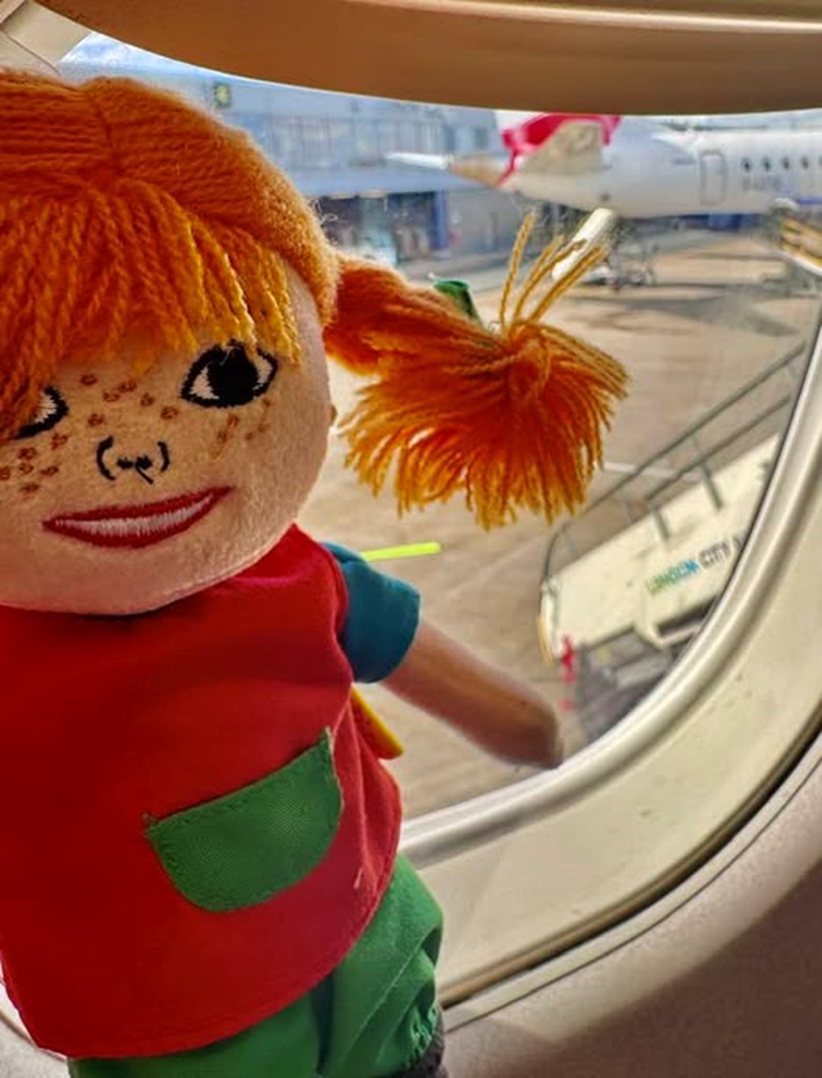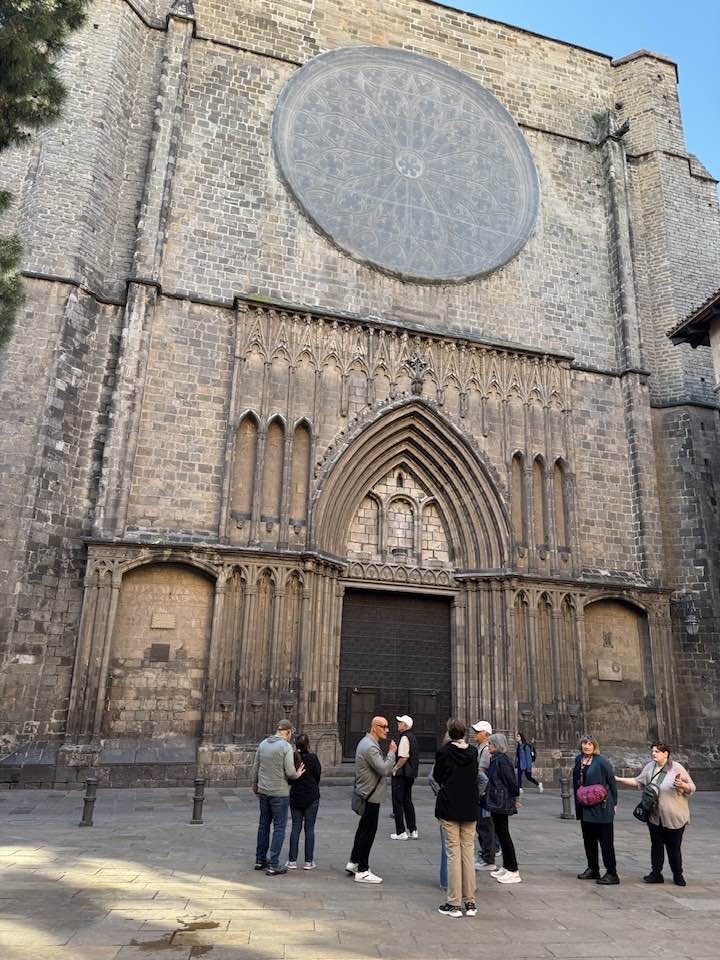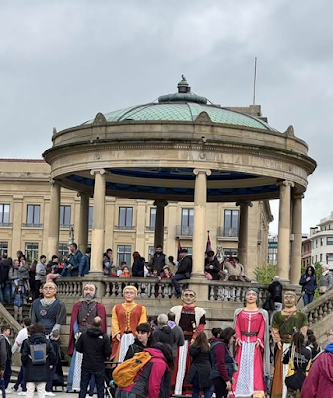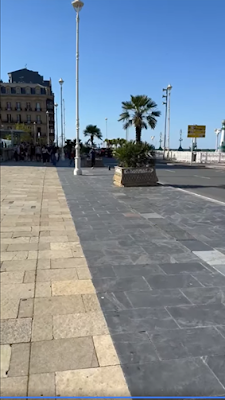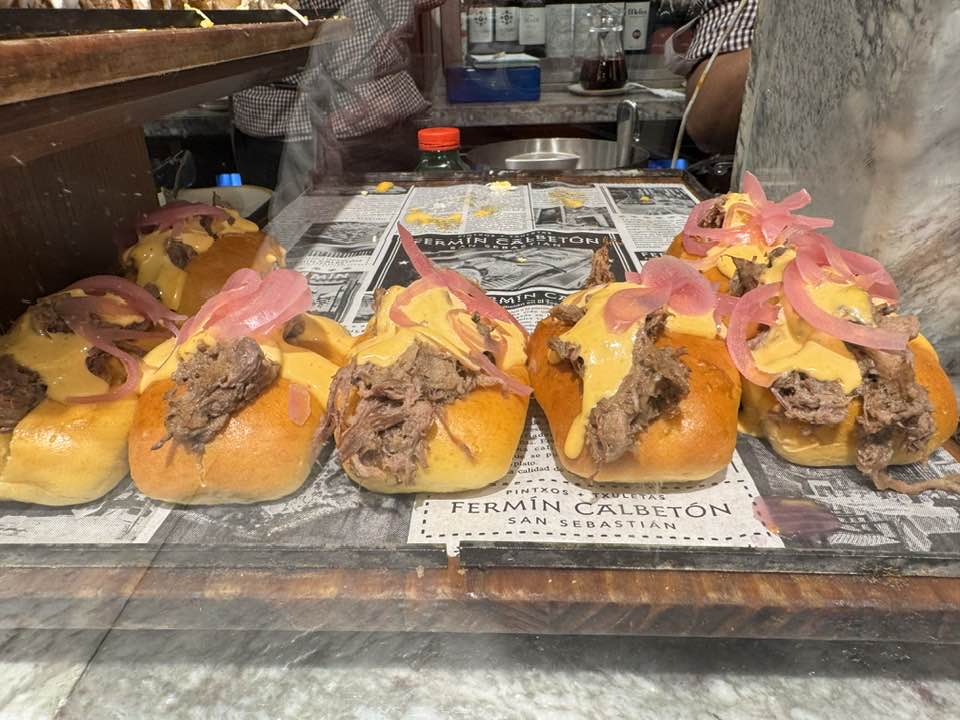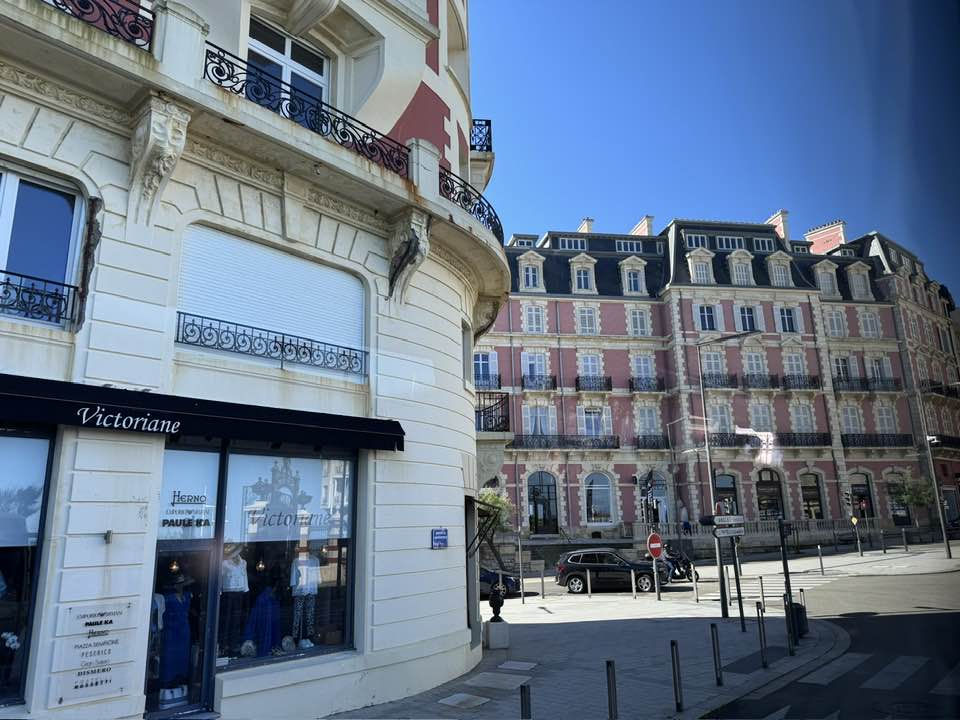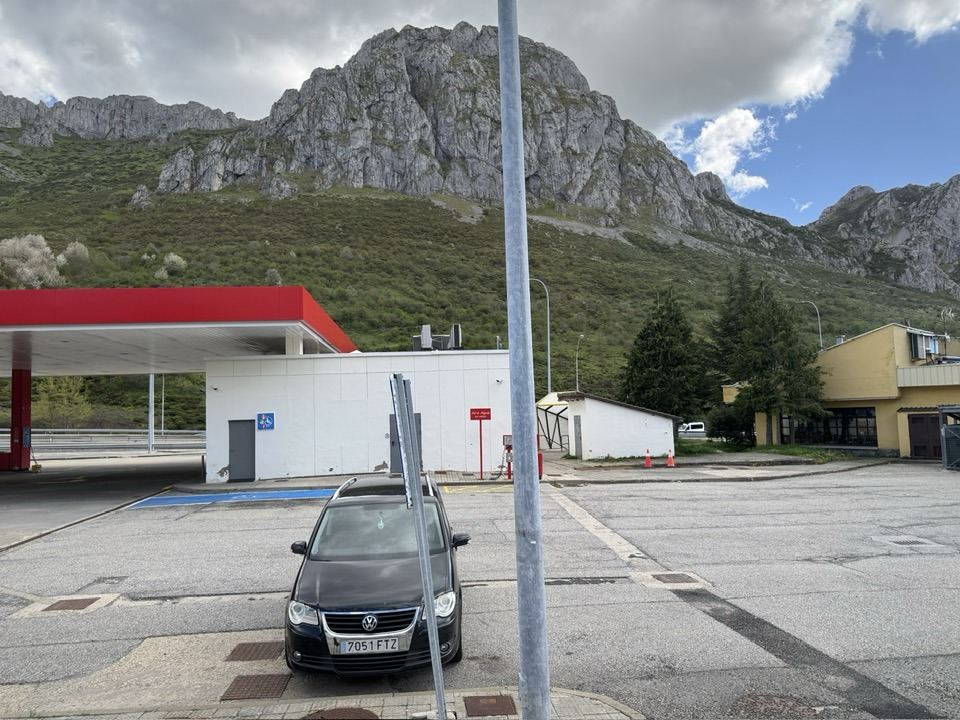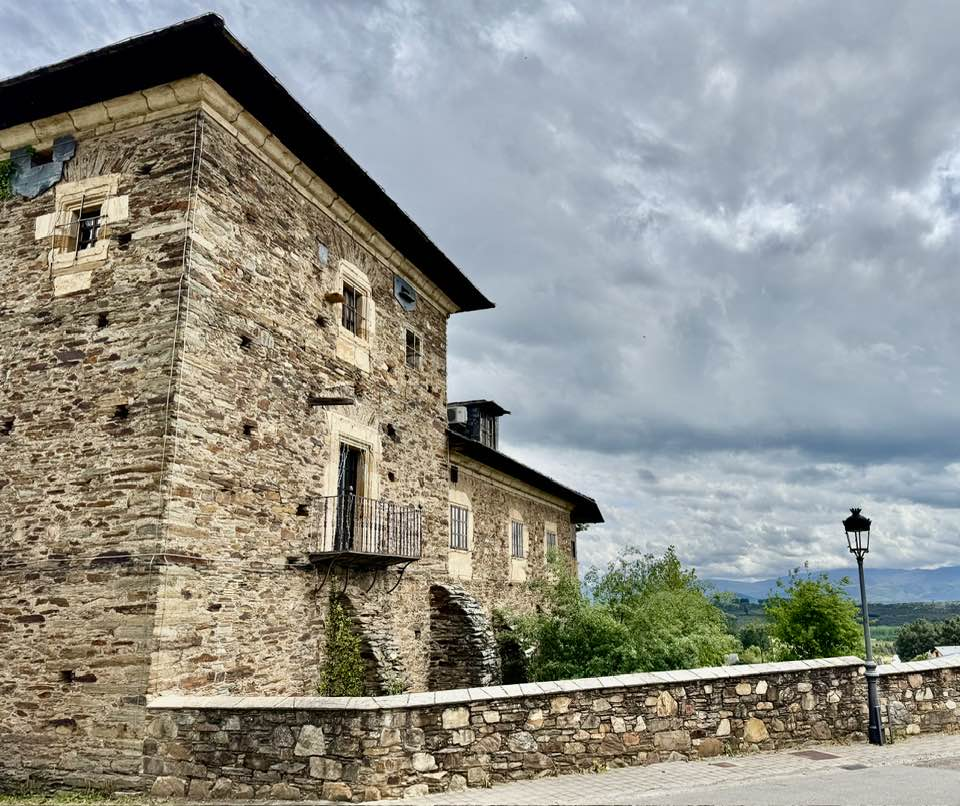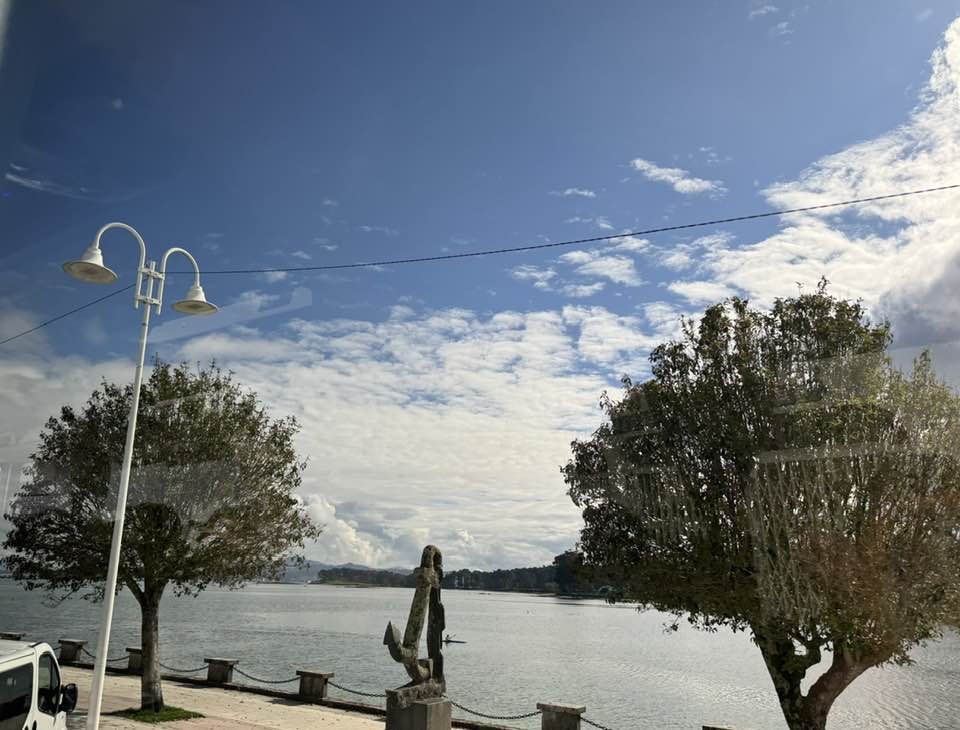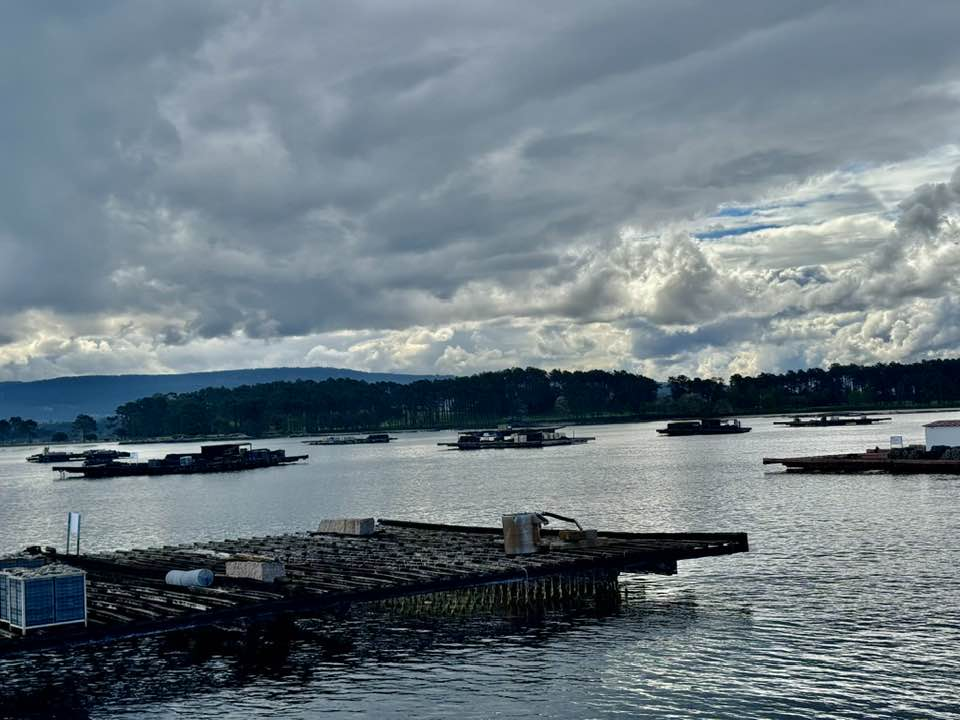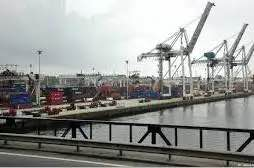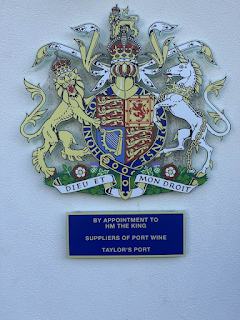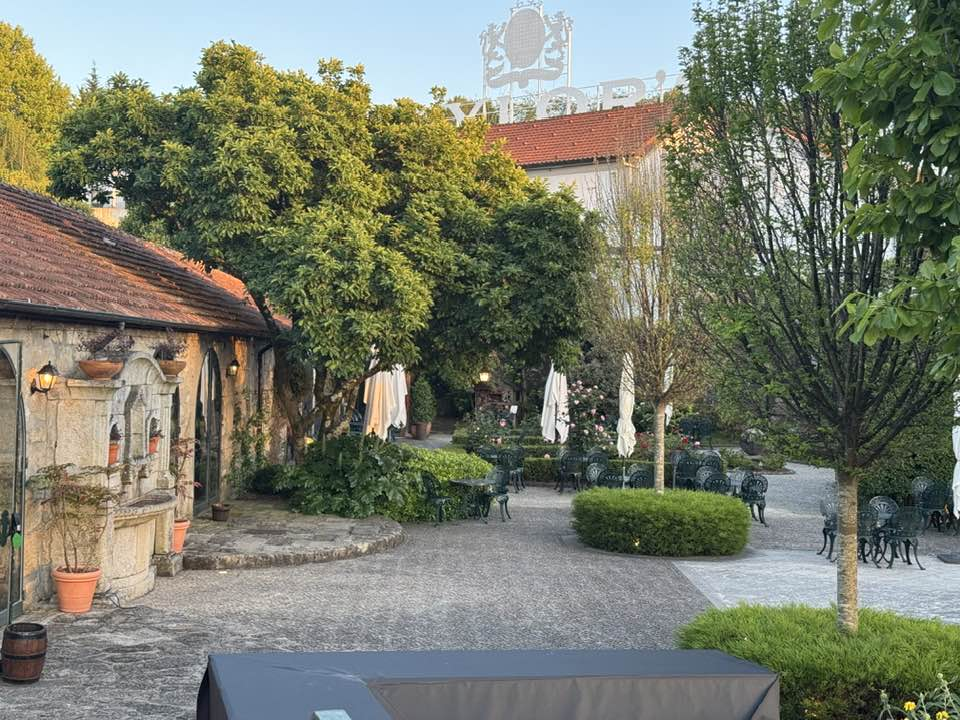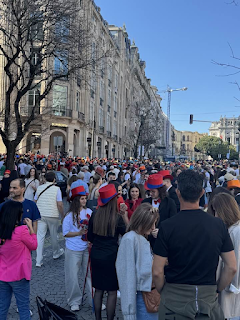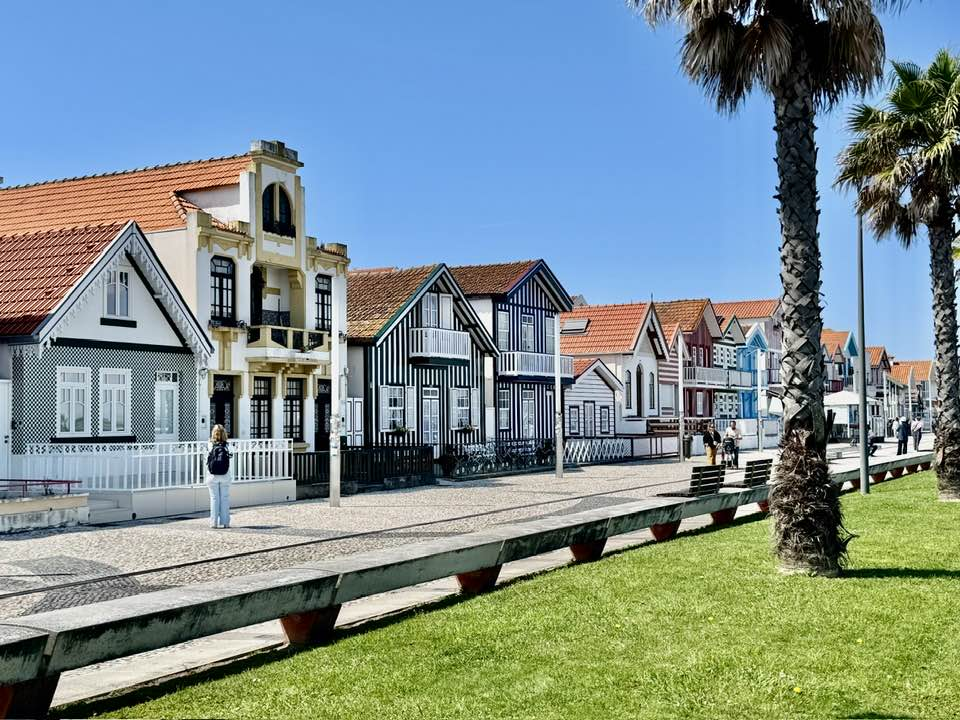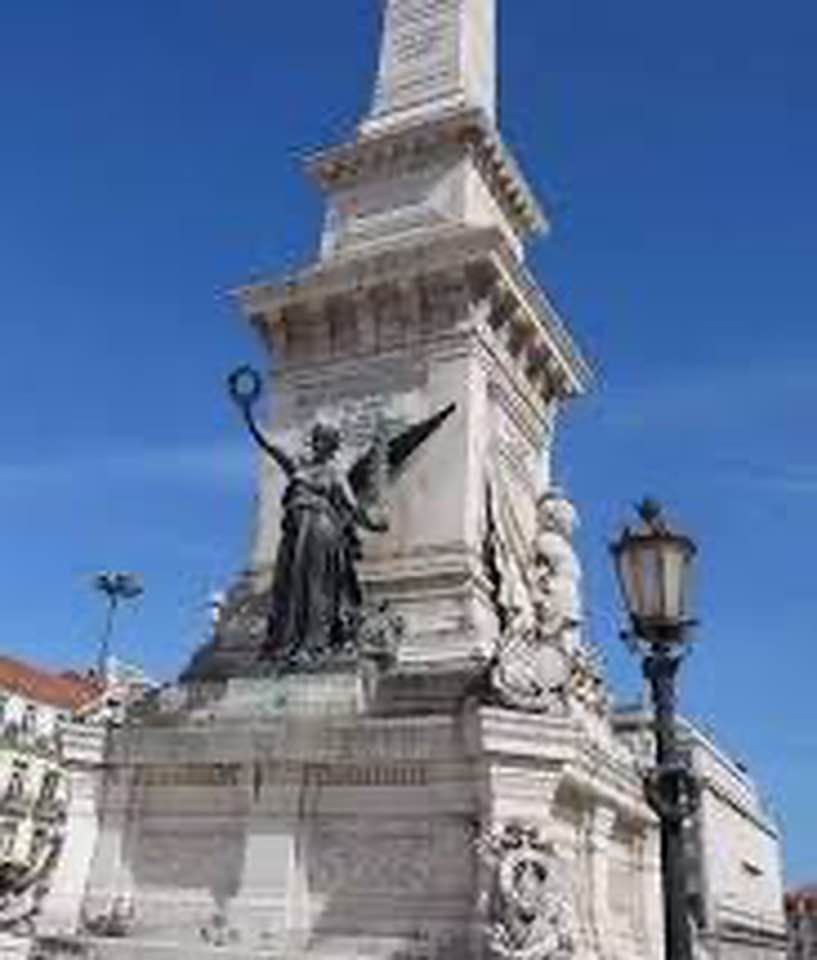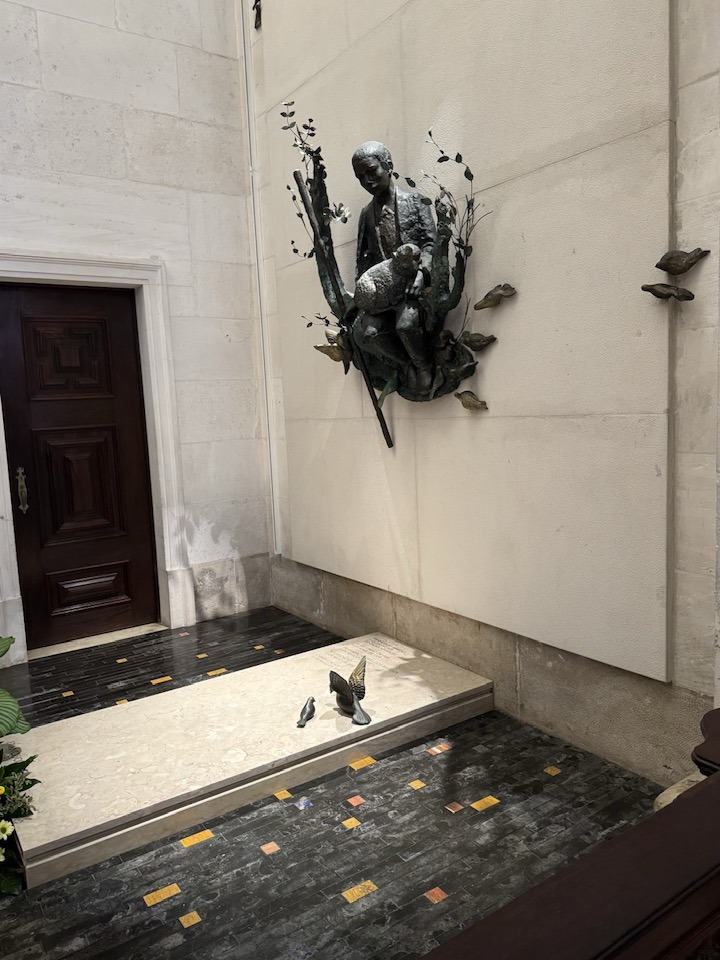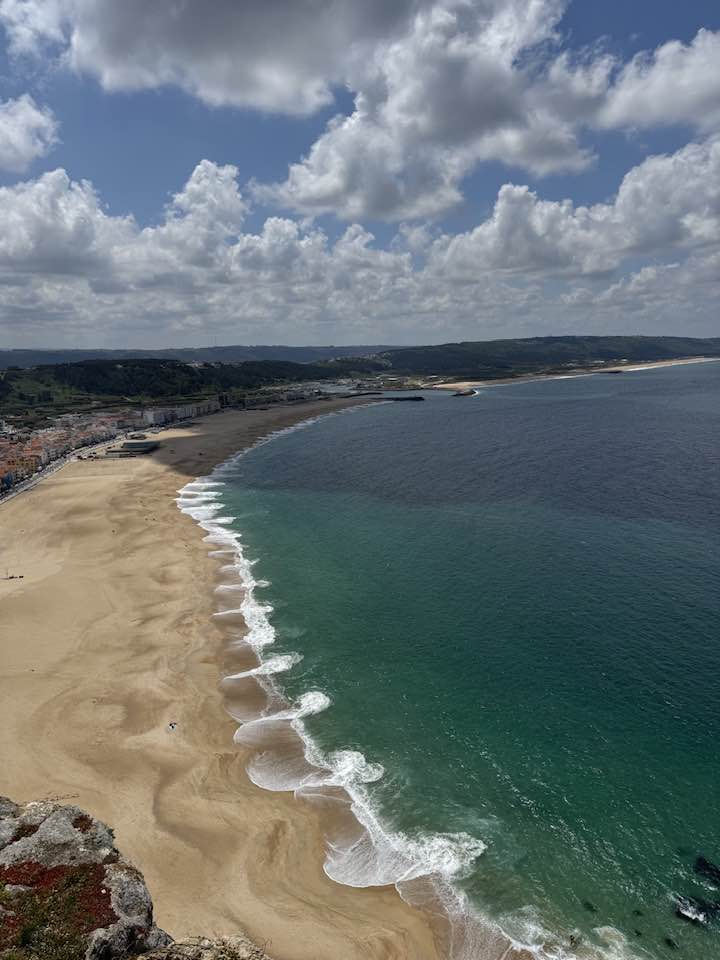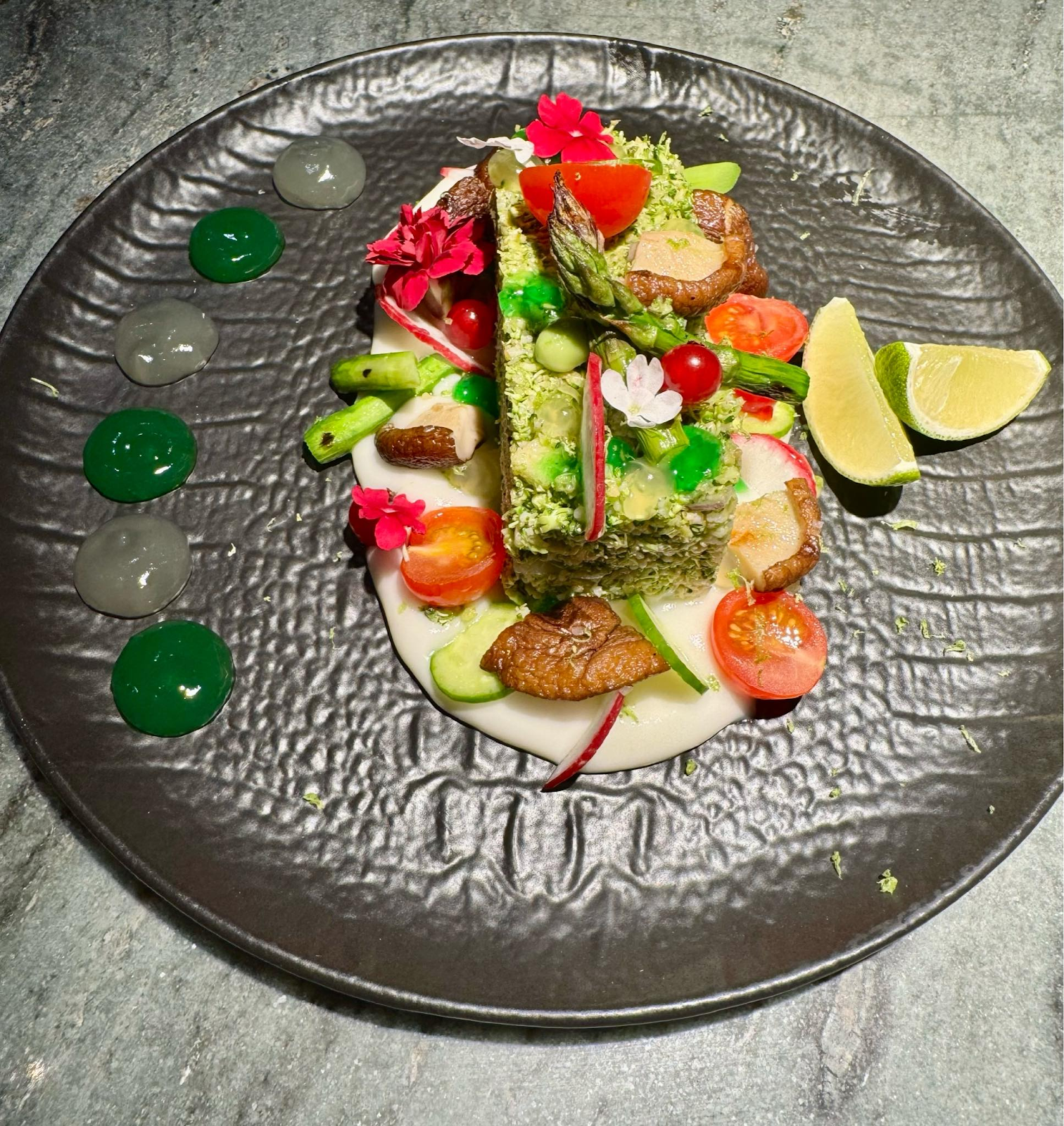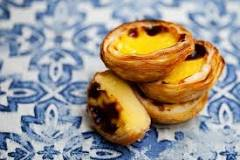It's been a long time since I've been to Portugal (and then, 53 years ago, it was only for a change of planes in Lisbon...), and I've never been to the northern parts of Spain, so it seemed like a good idea to sign up for the Tauck tour of Northern Spain (which used to be called Paradors of Spain).
So, On April 22, 2025, Pippi Longstocking and I are on our way to Barcelona. We have chosen to fly from London City airport, which is so much easier a place than Heathrow. Yes, we kind of miss the jetways and find it a bit humorous to climb up stairs to enter the plane as we used to do in developing country destinations, but that’s OK. A beautiful day to fly, and anticipating nice weather in Barcelona, where we land in mid afternoon during the festival called Saint Jordi Day – – also known as St. George’s Day. The plan is to pop the suitcase into the hotel, and get out on the streets to see what the festival is all about.
The flight from London to Barcelona is short, only an hour
and 40 minutes. Looking out the plane window, you get a sense of how green
England is, and then the next notable sight is the English shoreline
overlooking the English channel. Yesterday, it was quite cloudy over France,
and then Spain displays more hills and mountains than does England. Finally, we
see BARCELONA on the edge of the Mediterranean Sea.
From the Internet, more information about Sant Jordi festival in Barcelona and Catalonia. “It is a very popular festival that combines culture and romanticism, celebrating both World Book day, and Valentine’s Day. On this day, it is the custom for couples to exchange gifts: the men receive a book and the women receive a rose. However, this has developed over time, so both men and women can receive books and roses. Book and flower stalls are set up along the streets of Barcelona. The origin of the festival: this curious festival comes from a mixture of traditions from different periods. It coincides, on one hand, with the fact that Sant Jordi has been the patron saint of Catalonia since the 15th century, and on the other hand, it comes from a famous legend of St. George and the dragon (the knight defeats the dragon, who was terrorizing the village and the princess, and after penetrating the dragon with his sword, St. George gave the princess one of the beautiful red roses that spilled out of the beast’s body) and the old medieval tradition of visiting the chapel of Sant Jordi, where a rose fair or ‘lovers fair’ used to take place. This is why Sant Jordi is also the patron saint of lovers in Catalonia."
Barcelona has abolished bullfights. (Yippee!) This former stadium has been repurposed into a shopping mall.
The works comprising the collection came from the donation made by the artist himself when the museum opened in 1975. Over the years, other donations made by his wife and various members of the family have been added to it, as those from public and private collections. I particularly liked the work made from the burlap material used to gather grapes.
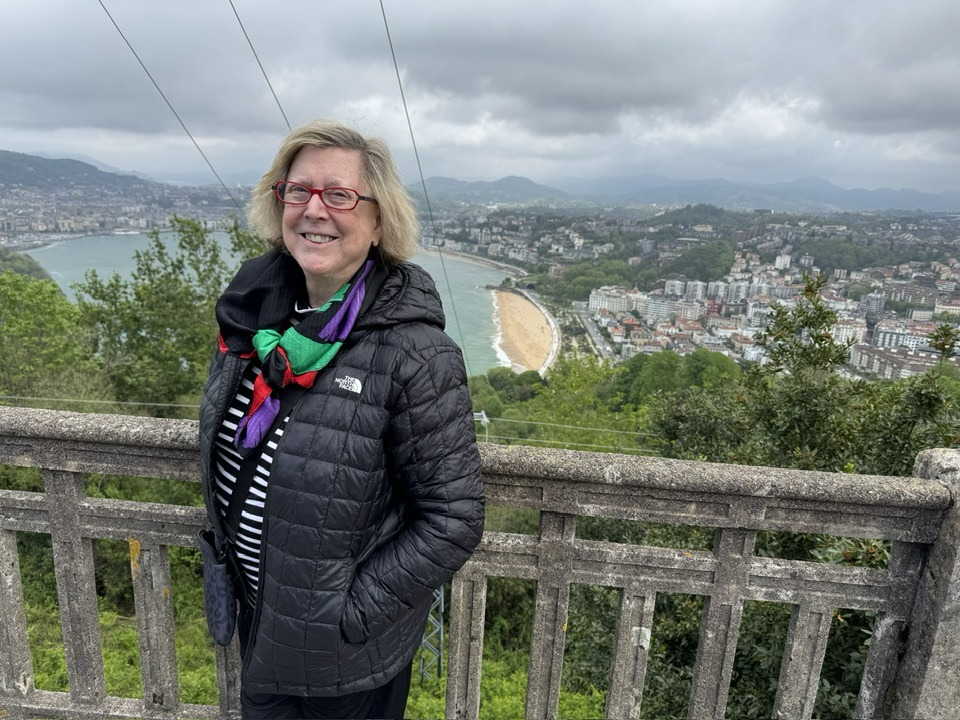 |
| A little bit chilly and rainy.... |
 |
 |
| In many places, I saw teenagers with surfboards...the sea is warm! The beach here is said to be a world-famous surfing beach. A visit to San Vicente Church in San Sebastian’s old town, built in the 16th century in Gothic style. It is thought to be the oldest church in San Sebastian. Our Belle-Epoque hotel, the Hotel Maria Cristina, was very convenient ... a short walk to the seaside Take the walk with me: the video is (click here) walk near the seaside or use your smartphone camera to open the QR code... The Plaza of the Constitution in the middle of Old Town has an interesting history. Every yellow balcony door is decorated with a number. This is because these houses were obligated to allow entrance to their balconies during bullfights, which used to take place in the center of the plaza. Today, a spot on these balconies is also cherished during the city's most important festivals. You can't say you have visited here unless you've enjoyed the local quick-food places, which are everywhere in the old town: Pintxo = those appetizer things, of which three or four pass for lunch in San Sebastián. Usually washed down with local wines or ciders. SPAIN/PORTUGAL/SOUTHERN FRANCE total power outage today—April 28, 2025 - thanks to my Facebook and other friends who got in touch with me when this news hit the world stage. I’m sure it was a terrible problem for air, flights, hospitals, etc.. The outage in San Sebastian (Bay of Biscay, Northern Spain)only lasted about 45 minutes. I don’t know about the rest of the Iberian Peninsula, and I understand that southern France was affected also. Lots of people’s cell phones are still not working on the Spanish networks, and my Verizon international roaming is iffy. My hotel Wi-Fi is OK, and that’s how I am doing this post. Everybody in our group was shocked when that outage happened — we were on a little tour of the old city, stopping to taste appetizers, those little things they put sticks through and call them pintxos. In comparison to the outages we go through frequently during winters up at Lake Tahoe, in terms of length of some outages, this situation on the Iberian peninsula is a piece of cake. However, I don’t think anyone knows yet what the cause was. And last but not least in the walk around town, an important sign of the times. Europeans are disgusted with what the US president is doing in the world.... Take a look at a video of the panoramic view of Biarritz from the lighthouse lookout: https://www.facebook.com/592039044/videos/pcb.10164829604619045/708983081801049 or use your smartphone camera to open the QR code.... In 1854, Napoleon III commissioned the Hotel du Palais Biarritz as a gift for Empress Eugénie. It was renovated recently as a Hyatt hotel; it is the red brick building on the left on the beach; next to it on the right Napoleon built a casino to entertain her. Downtown Biarritz today features lots of high end local boutiques - and other parts of town has coffee shops catering to surfers and tourists on a moderate budget. Take a walk through this church with me! See the suspended boat ... a feature of all Basque churches Video: click here to walk through the church or use your smartphone camera to open the QR code: April 29 in Saint-Jean de Luc was farmers market day and before I walked the shop-laden streets of this popular tourist town, I took a look at some of the fresh produce grown in the region. Right now, it is the season for white asparagus! April 29- did I mention that Saint-Jean de Luc is a port city with access to the ocean? Privateers brought a lot of wealth to this town. Today, it is tourist revenues that bring the wealth, and beautiful beaches, even though the water might be a tad cold at this time of year, attract lots of swimmers. Take a look at the beautiful homes built by Privateers in this town....click here to see the video click here or use your smartphone camera to open the QR code.. April 29, on our way back to San Sebastian, we stopped in the small Basque village of BIRALOU. A walk to the top of the village led to a small church, an auberge, and a municipal building. In front of all was a small plaza with lines drawn on the ground and walls, where the children could play jai alai after church and after school. The real treat was a jai alai demonstration of a short game at the local sports center, followed by local beer, and Basque cake filled with raspberry. The player in red, 23 years old, had just returned from several months playing professionally in Florida. The fellow in blue was his high school coach. The lady match judge made the exhibition game fun by allowing our group to place some bets on the outcome. Want to guess who won the match? or open the QR code with your smartphone camera... April 30. - leaving San Sebastian for a 90 minute drive through Basque country en route to Bilboa in Bilboa, the major attraction is the Frank Gehry-designed Guggenheim museum. Soaring titanium curves with gorgeous outdoor terraces, one of which is accented by a flower adorned dog designed by Jeff Koons and appropriately named PUPPY, which, (we are informed) in the local dialect is called POOPY. April 30 in Bilboa - more than 1 million visitors a year flood the Guggenheim Balboa Museum, mostly to see the building itself, which is an intricate jungle of shiny titanium curves with wings of Spanish limestone. It is sent grandly on the riverbank of the Nervion river. . The artists inside the museum span the mid 20th century to the present, including Willem de Kooning, Robert Motherwell, Anselm Kiefer, and Richard Serra. The first floor of the Guggenheim museum is an artistic delight itself, with marvelous atrium shapes, and beautiful natural light. A huge attraction on the main floor in a gallery specifically designed by Frank Gehry to contain no columns, is the sculpture made of steel by Frank Serra and appropriately named “snake.“ Using iron as the artistic material was intentional, as Bilboa used to be a rust-belt town that produced steel, and which like many towns in the USA’s rust belt, fell into hard times when inexpensive imports cratered the price of domestically produced steel. The town of Bilboa invested $200 million to help make the Guggenheim museum happen, and thus revived the town and its economy. Today, Bilboa is thriving. April 30 in Bilboa / Helen Frankenthaler’s works are featured in the Guggenheim museum currently April 30, our tour group drove from Bilboa to Santillana Del Mar. This is a well-known and charming medieval town located in the Cantabria region of Spain. The town has a well-preserved historic center, cobbled streets, and impressive medieval architecture; it is a registered National Monument. Someday I’d like to return and see the nearby museum dedicated to the Altamira Caves as our tour does not include this (the caves themselves are closed to the public due to problems with humanity, degrading the thousands-year old paintings of bison). In this town, however, lots of places to dine, and interesting cobbled streets to walk. Our group had lunch at the Parador Gil Blas. April 30, we stayed overnight at one of Spain’s Paradors, Parador Cangas de Onís in the Austurian region. Located on this property is the ancient monastery of San Pedro de Villaneuva. The inscription on the tapestry that hangs in the hallway near the reception area, says “foundation of this monastery for the King Alfonso I on 21 February in the year 746”. Between the 12th and 13th centuries, Saint Peter‘s monastery at Villanueva was composed of the cloister and the adjoining church. Only some parts of the church, the Romanesque arches of Saint Michael’s Chapel, several gravestones and a few isolated architectural pieces have survived from this period. The church is the only building of the monastery that conserved significant elements of the early medieval construction. April 30 -This well, located beneath the annex to the monastery of San Pedro de Villaneuva, is part of the archaeological finds which appeared during excavations in the 1990s due to construction work on the Parador Cangas de Onis. According to monastery records, the well was built in 1685 by local master stonemasons to replace an earlier one. Inside this room, it is possible to see a portion of the 12th century Romanesque structure. This is part of the archaeological finds discovered between 1995 and 1997, when an ambitious excavation plan was undertaken. The dating of these remains determined that there were indeed grounds to support the tradition of linking the monastery’s founding to the first Asturian monarchies. April 30- Wandering around the Parador Congas de Onis leads to many interesting sights. Pippi Longstocking is, in fact, the strongest girl in the world, but even she would find it difficult to open this large old door. This door, made around 1700, adorned the main entrance to the monastery. The conversion from monastery to a Parador de Turismo enabled it to be recovered, and today it forms part of the artistic and artisanal heritage of the hotel. May 1 - a walk with a naturalist around the village of Congas de Onis in beautiful
weather showed lots of lovely houses. Of note are the raised granaries of the region, called HORREO. These traditional granaries are perhaps the most characteristic buildings of the Asturian countryside – – we saw them as we passed small farms, and apparently they are in many villages too. Read more about horreos here: https://www.barcelo.com/.../things-to-do/granaries-asturias/ Our walk through the nearby village led to a pedestrian bridge over the Sella River; it looks out over the National Park of the Picos de Europa mountains. May 1 - My hotel in Leon for the evening: The historic San Marcos monastery was
originally built in the 12th century (circa 1152) as a pilgrims’ hospital and monastery
for the Order of Santiago. However, the stunning Renaissance-Plateresque building
that stands today was mostly constructed in the 16th century. Today, it operates as
a luxury hotel (Parador) and museum. Stroll with me: click here 3369721 Enjoy the music and the scene: use your smartphone camera to open the QR code May 1 - part of my evening walk… I enjoyed a moment of rest with eL Peregrino…
according to TripAdvisor, the statue represents the pilgrims who walk from all over
Europe to the Santiago de Compestella where the remains of Saint James are
supposedly held. Many walk this main "French Way" Camino Trail and pass this spot in
Leon, which is directly in front of the Convent de San Marcos, which is now a parador
in which our group is staying this evening. May 2 morning: it is raining pretty hard in Leon today, so Pippi and I have opted out of the two hour walking tour as my gimpy right knee is not doing very well in the rain and cold. I hate to miss out on anything, but maybe we will come back at another time and see those sights again. In the meantime, we are hanging out in the Parador, enjoying the many lovely touches that came with the renovation of San Marcos monastery into this hotel. Next stop is Santiago de Compostela... Our last stop in Leon was to a café in the neighborhood of the cathedral (I didn’t take
that walking tour, just to be clear, as most of the Leon pedestrian streets are
cobblestones). Waiting for us was a thick drinking chocolate, perfect for dipping
homemade churros! May 2 - on the highway as we approach Santiago de Compostela, we see lots of
stands of eucalyptus trees. They were imported from Australia in the late 1800s, and
today are used for the production of paper pulp, frames that are used to harvest
mussels (because the oil in the wood does not disintegrate in the salt water), oil for
various pharmaceuticals and cosmetics, and furniture. There is an ongoing
conversation about their flammability in drought conditions, but farmers and
landowners continue to plant and harvest them. May 2, afternoon. Our Tauck tour guide, Mitchell Blom, is a font of lots of interesting information. Today we drove through this town, MELIDE, and although there was no need to stop, Mitchell told the story of how the town last year produced the world’s largest omelette. He said it had to be turned over with a series of rope hoists. Here’s a YouTube video of that happening. https://www.youtube.com/watch?v=aGa0oOn1NJM It is impossible to praise the beauty of the Spanish countryside too much. I am sure
that an auto tour here would be very pleasant, but even from our tour bus windows,
it’s easy to be astounded by how gorgeous this landscape is. ... at Palacio de Canedo/ beautiful views of their vineyards, the old stone buildings
which comprise the hotel and restaurant compound, and some incredible interior
spaces as well. This is actually a small hotel, and I’m sure it is delightful to stay there.
Maybe later! May 2 - late afternoon, we arrive in Santiago de Compostela BACKGROUND FROM TAUCK: "When what was believed to be the grave of St James
the Greater was discovered in this region of what is now northern Spain in the ninth
century, hundreds of thousands began making the arduous pilgrimage along El Camino
de Santiago - the Way of St. James - on foot to visit it. Legend has it that a bright star
led a shepherd boy to the forgotten tomb of the aspostle, and today the world-famous
11th century Rmanesque Cathedral of St James is home to the relics of the saint." There is a midday Pilgrim’s mass. The cathedral, constructed starting in 1078, is Romanesque with a 17th century baroque facelift. The 12th century arch called the portal of glory has a custom of placing your fingers in the well worn indentations made by the touch of those who came before you.Pilgrims also hug the bejeweled statue of Saint James. Santiago de Compostela is in Galicia, a sparsely populated region in Spain Northwest pilgrims, make their way here on several routes, which converge in Santiago de Compostela, and the Camino, or way of Saint James, his name for the belief that the cathedral houses the remains of the apostle St. James. We checked into the centrally located hotel created from a medieval hospital, the
|Parador Hostal de los Reyes Católicos, also known as the Parador de Santiago
de Compostela, considered to be one of the oldest hotels in the world as it has
welcomed travelers since the 15th century. It was established to help pilgrims
making their way along the El Camino. Although the Parador is partially under
renovation (interestingly, the renovated workings of the building are wrapped with a
mural, which will show the completed project) our rooms are comfortable, and there are
four courtyards, each of which are as beautiful as the next, with amazing architectural
features everywhere you look. We just got checked into the Parador before the skies
opened up with an incredible thunder and lightning rainstorm. May 3 - we talked with some folks from Texas who did the pilgrims walk all the way
from the French border; it took them 35 days, resulted in blistered feet that hurt so
much they became numb, and finally, they followed the signs of the pilgrim’s Way
and ended their pilgrimage in the Plaza del Obradioro. The plaza has several “routes” you can see with a middle junction, as pilgrims start
from France, Portugal, Granada and other locations in Spain. Those who have done the pilgrimage with a spiritual journey in mind constitute about 93% of the walkers; the pilgrimage can also be done on bicycle and on horseback. Once accomplished, the “Passport” originally issued at the onset of the route, is stamped in Santiago and an official certificate is awarded. The primary symbols used for signage on the Camino de Santiago are the scallop shell and the yellow arrow. The scallop shell, often found on the shores in Galicia, is a recognizable symbol of the Camino and serves as a wayfinding tool. The yellow arrows are painted on various surfaces like walls, trees, and stones, guiding pilgrims along the routes. Rather than giving you bits and pieces of information about the central square and the significance of the buildings here, please take a look at this website. https://www.santiagoturismo.com/rutas/praza-do-obradoiro at this point, I am pretty churched out, so I am just posting some images of the beautiful Santiago Cathedral , interior and exterior. Many pilgrims come into the cathedral and wait in long lines to go into the crypt where relics of Saint James are kept, and then proceed to part of the cathedral where they give a hug to the statue of Saint James. (Our group did not wait in line and, as far as I know, no one went back to do that statue hug). But millions of people do that each year. It is an important part of the finalization of the pilgrimage. The Cathedral has an amazing museum of religious statues and artifacts, including a library with an incredible ceiling. Forgive me if I can’t remember exactly which martyr it was who had all of these knives stuck into him. Maybe you know? May 4 - beautiful morning weather in Santiago de Compostela, illuminating the street down which pilgrims walk to get their certificates of completion. It’s Mother’s Day here in Spain, and a special procession of schoolchildren came out of the side street, bearing a statue of Mary, and held a celebration in the middle of the square. Pippi Longstocking says goodbye to Santiago de Compostela, pausing to hear the birdsongs and enjoy the serenity of one of the courtyards of the historic parador. May 4, we drove to the coastal town of Ogrove. There, we board a boat to go out to the bay, where mussels and oysters are farmed. Afterwards, for lunch, we are presented with freshly caught and steamed mussels, of course some wine, and the usual Spanish cheeses and ham. Wonderful lunch on Spanish Mother’s Day! As we disembark from the boat at Ogrove, a vendor at the end of the pier was selling a very special treat – – BARQUILLOS, a very light waffle-like confection, shaped like little boats. A real treat, at one euro for a package of two. May 4, we continue our motorcoach journey towards Porto. The rugged Spanish coast features lovely seaside towns In the afternoon, we stopped at the small town of Viana do Castelo for a quick walk around, cup of coffee…and SURPRISE a boys club dedicated to traditional Portuguese music which was practicing at the side of the parking place near the cultural center on the river. Enjoy! to hear the music, use your smartphone to open the QR code or click on this link: music! Just a pretty display for tourist photos, but representative of windows and building styles in this part of Portugal May 4 - You would think that a city named Porto would be so named because it was a port on the seacoast. However Porto doesn’t have a deepwater harbor of its own due to a sandbar. Instead, the port which serves this city is the Port of Leixões, a primary seaport for the city of Porto and the Northern Region of Portugal. Per google: “Located in Matosinhos, 4 km north of the Douro River mouth, it serves as a gateway for both cargo and passenger traffic, including cruise ships. The port is an artificial harbor on the Atlantic Ocean, with two breakwaters forming the harbor.” We saw this port remotely, on our way into the city. Our hotel in Porto, the Intercontinental Porto, is also known as the Palacio das Cardosas. This is probably the most beautiful traditional hotel our tour group stayed in. Built in the 18th century and located in Baixa, a neighborhood in the heart of Porto, it was originally a grand home (“palacio”) for the wealthy family Cardosas. It forms one side of the main city square, which, unfortunately, is in the middle of being torn up to expand the subway system in Porto. However, that does not affect this nicely restored hotel. May 5 - we begin our city tour right across the street from our hotel, at the Sao Bento train station. Opened in 1916, it was built in the early 20th century in a spot where once stood a convent. The lobby of the train station is covered with 20,000 tiles, and this train station is said to be one of the most remarkable artistic enterprises that marked the beginning of the 20th century A lovely walk down the Rua das Flores, a historic pedestrian street originally lined with gardens of houses, which gardens were filled with flowers. The gardens are no longer there, but some of the tile work pays tribute to the original character of the street. The street was built between 1521 and 1525, with the goal of improving access to the Monastery of S. Bento de Ave-Maria. (The monastery is now the site of a train station…see previous post) To end today's guided tour of Porto, we took a boat ride on the Douro river, which passed under many beautiful bridges, one of which was built by Eiffel. At the end of the ride, we found ourselves on the Gaia side of the river, in an active area which features lots of small cafés and shops, and of course, the usual street musicians. May 5 - We end our wonderful Tauck tour with the farewell dinner at a port house, in this instance Taylor’s; there are many port manufactures here as you probably know. Taylor’s features a lovely garden and restaurant. The dinner was highlighted by a performance of traditional Fado music. Lovely sunset over Porto this night! to hear her,open the QR code with your smartphone camera: May 6 - it is end of the term time for the thousands of students at universities in Porto. They are celebrating in the cafés, at a major evening get together at a plaza, and receive congratulations from their peers and their friends everywhere you look. Each curriculum is distinguished by a color, and many of the students sport a top hat, a jacket, and a color coordinated walking cane as part of their celebration regalia. Exams are yet to be done, and then degrees will be awarded. In the Portuguese university system, after three years, students receive a baccalaureate, and two more years leads to a masters degree. As you can imagine, at this time of year the beer flows freely…. May 6. - walking around Porto, I see a shop that specializes in sardines. Packaged and prepared in a multitude of ways, they are smartly marketed by a carousel in the window to attract tourist attention. We have all heard of organ grinders, but I don’t think I’ve seen any before. This fellow has a unique act, utilizing tame doves, chickens, and parrots. He is smartly located on the street on the way to the Lello library. There are 58 churches in Porto, so just about everywhere you look, you come across one. During this trip, our tour group saw the inside of many churches and cathedrals, so at this point, I just admired the architecture and tile work on the outside May 7 - Pippi Longstocking and I took a half day trip out of Porto to see some of the coast nearby. Our first stop on the crowded bus tour was Costa Nova. The most iconic feature of Costa Nova is its colorful striped houses, which were traditionally used by fishermen to store equipment. This is a charming seaside village; its distinctive, colorful striped houses are known as "palheiros”. It has a beautiful sandy beach and offers a blend of traditional fishing culture, world-class surfing, and a relaxed beach atmosphere. The village is a popular destination for tourists! May 7 - the next stop on our half day bus tour was Aveiro, often referred to as the Venice of Portugal. We took a ride through the canals on a typical boat, known as a.”Moliceiro”, passing under pedestrian bridges where colorful ribbons are tied by sweethearts and others who wish to commemorate a special occasion. I stopped at a bake shop in the shopping area of the town – – and what a shopping area, with all of the high-end brands that you might ever want! – – to sample the traditional pastry made only in this town. The traditional commerce of this area is a harvesting of salt from salt pans, and of course fishing. Ovos Moles de Aveiro is one of the best known Portuguese sweets. First made over five centuries ago by nuns in the local convent of Jesus in Aveiro, the “Soft Eggs of Aveiro” is made by adding raw egg yolks to a sugar syrup. They can be presented as they are, wrapped in a wafer. They may or may not be covered with a thin layer of sugar or chocolate syrup. Rumor has it that the egg whites are used to produce communion wafers, and that left lots of egg yolks to be dealt with... No visit to a developed country is complete without stopping at a local fast food chain restaurant. But the McDonald’s in Porto is above and beyond the usual. Beautiful chandeliers, and stained glass windows inside and an amazing exterior as well. Popular with students, and of course, everyone. May 8- oh how I hate bus travel! You can’t get up and walk around, there is no food service available, and the restroom on a long distance bus is unspeakable. It’s a train for me every single time I can choose, but today – – no choice because of the train strike throughout Portugal. At least the bus station in Lisbon is architecturally lovely as you approach it. WELL, HELLO LISBON! After I checked into my hotel – I decided it was at least time for a decent meal. So I walked down to a restaurant with a lovely outdoor patio, Pinoguio. Good food and moderately priced, and it made my heart happy to have really wonderful olives and bread presented immediately after I sat down. The restaurant is located just off Restauradores Square, at the southeastern end of Avenida da Liberdade. This is a prominent public square dedicated to the restoration of Portuguese independence in 1640, and a key feature is the Monument to the Restorers, an obelisk erected in 1886, with the names and dates of battles fought during the Portuguese Restoration War. By the way, Lisbon is at the end of the Tagus river, and has a busy port area with lots of freight and passenger cruise boats. (that naughty artist... note upper right) May 9 and many other days in Portugal - about tiles - The “Azulejo” is an identitary art of Portugal. It has been uninterrupted in its use throughout the past five centuries. Glazed tiled pavements, for example, were used since the 13th century. In the early 16th century, the use of tiles as wall decorations was found throughout Portugal, based on patterns of the Hispanic-Moorish tiles produced in Seville and Toledo. Throughout the 16th century, the Islamic motifs were gradually replaced by European motifs. Many of the exhibits at the museum in Lisbon show the use of times in other art forms through the centuries, and today. More about tiles: (from invaluble.com)... "When visiting Portugal — particularly its capital, Lisbon — glazed ceramic tiles are a common sight. They adorn buildings, both inside and out, adding intrigue, shimmer and variety. This decorative art form, traditionally comprising small glazed tiles is called “azulejos,” derived from the Arabic word الزليج (“al zulaycha”), meaning “small polished stones.” Dating back to the 13th century, the first Portuguese art comprising ceramic tiles appeared shortly after the Moors invaded Portugal, bringing their culture with them. Today painted azulejos that depict scenes and narratives are often installed on benches, train stations, the interiors of churches, sidewalks, and houses. In the the 16th century Azulejo tiles became a notable fixture in Portuguese culture. After visiting the Spanish city of Sevilla and Granada’s Alhambra Palace in the south of Spain, King Manuel I of Portugal was impressed with the intricate tile designs that he saw. He used his wealth to import azulejos to his palace in Sintra, a Portuguese municipality northwest of Lisbon. Thereafter, ceramic tile art rapidly grew in popularity, with influential members of the monarchy and the church commissioning pieces. The colors found in the first azulejos included blue, yellow, green, and white. During the Age of Discoveries (15th – 18th centuries), this shifted, and Portuguese tile art began featuring predominantly blues and whites in painted scenes. The import of Chinese porcelain and Dutch Delftware (ceramics made in the Netherlands) may have influenced this shift. In fact, Portuguese nobility so highly demanded Dutch tiles that the government implemented an import ban to support local artisans. If you visit Portugal today, however, you will see tiles of all colors." Many think of Portuguese tile art as those that you see on the façade of buildings, or perhaps on the interior of modern kitchens today. But this museum gives an entirely new perspective on tile art. For example, there is the replica of the panel produced for the Portuguese pavilion of the 1937 Paris international exhibition, which shows an orderly Lisbon of streets and staircases, primarily in reds and yellows, but of course with the bay at the bottom in blue. Then, there is the incredible long panel of the city before the 1755 earthquake and tsunami which destroyed much of Lisbon. This is entirely in blue and white. May 11 is coming up - Happy Mother’s Day! I miss my mother, also known as Grandma Mary, every day. In her honor, I posted one of her recipes on the recipe wall at the National Tile Museum in Lisbon Portugal.
1st stop in the day trip out Lisbon was to the city of Fatima. Fatima is a very Important Christian pilgrimage site, where the Virgin Mary is said to appeared to three children in 1917. The tree in the middle of the site marks the spot where the Virgin Mary allegedly appeared. Some pilgrims mark the end of their trip to the site by approaching the Chapel of the Apparition (in the middle of the complex) for the last 600 feet on their knees. In truth, because it was raining, I did not explore the whole complex, but the parking lots were full of camper vans and cars, so it clearly is an important pilgrimage site in Catholicism. Other parts of the site include the Basílica de Nossa Senhora do Rosário (Basilica of the Rosary) wherein the three teens who saw the apparition are interred, and a huge modern church at the far end. Our second stop is Nazare. It is one of the most popular seaside resorts in the so-called Silver Coast in the central western coast of Portugal. It is famed as a surfing destination, and also for the seven-layered skirts that is traditional for the wives of fishermen to wear. The Nazarene coastline is among the most dangerous in the Portugal due to the high waves that form because of the underwater Nazare Canyon. The canyon increases and converges the incoming ocean swell which, in conjunction with the local water current, dramatically enlarges wave heights. Due to the height of the waves, some as high as 80 feet, numerous surfing records have been set at Nazaré. The name Nazaré is the Portuguese version of Nazareth, the biblical city in the Holy Land. In the town square, a vendor shows off her traditional multiple petticoats. Rick Steves says: "Nazaré is famous for its traditionally clad women who — at least according to local lore — wear skirts with seven petticoats. Is that one for each day, or for the seven colors of the rainbow, or…? Make up your own legend. While the story you'll hear may be an invention for the tourists, it contains an element of truth. In the old days, women would wait on the beach for their fishermen to sail home. To keep warm in the face of a cold sea wind, they'd wear several petticoats so they could fold layers over their heads, backs, and legs as needed. Even today, older and more traditional women wear skirts made bulky by several — but maybe not seven — petticoats. The ensemble — with boldly clashing colors — is completed with house slippers, a hand-embroidered apron, woolen cape, head scarf, and flamboyant jewelry, including chunky gold earrings (often passed down from mother to daughter). " The last stop on the day trip out of Lisbon is Sintra. Sintra is a 19th century resort town as well as a royal retreat; it was a favorite of Lord Byron. It is one of the loveliest mountain villages in Portugal and a favorite summer residence of the Portuguese royal family for more than 500 years. Lord Byron once called “perhaps the most delightful village in Europe“. The Pena Palace is a romanticist castle in the municipality of Sintra, on the Portuguese Riviera. The castle stands on the top of the hill in the Sintra mountains above the town of Sintra, and on a clear day, it can easily be seen from Lisbon. It is a national monument and constitutes one of the major expressions of the 19th century romanticism in the world. it is a UNESCO world heritage site and one of the Seven Wonders of Portugal. It is also used for state occasions by the president of the Portuguese Republican, other government officials. May 10 - FOOD PORN ALERT! One of my good friends cautioned me against posting food porn, but I really can’t help it in this instance. After 11 hours of tours today, I returned to my hotel in Lisbon, which is called “Hotel Hotel“, and although the hotel is pretty modern, and I initially thought I’d be unhappy here, I am mistaken. Part of the reason is their excellent restaurant, called ANIMAL, which is near the reception desk and is a casual dining restaurant . The dish you see below is actually an appetizer, quite large enough for an evening meal as far as I’m concerned, and it is a combination of couscous, chopped broccoli, asparagus spears, and a adorned with some edible flowers, small cucumber slices, and cherry tomatoes. On the side are dollops of citrus gel, and sweet jalapeño gel. The couscous is formed into a slice, (as you can see) and put on a bed of vegan mayonnaise. A few slices of lime are part of the presentation, and in fact they do enhance the taste.I simply can’t believe how talented the chef is at this somewhat out-of-the-way restaurant, but if you’re in Lisbon, make a point to go here. Of course it pairs wonderfully with their house white wine, a Vinho Branco from producer Conde Vimioso, which is a blend of grapes I’m not really familiar with, including Fernao Pires, Arinto, and Verdelho. Part of the grapes are aged in French oak. 12 1/2% alcohol, produced in Portugal, and really yummy! Great way to relax at the end of a really busy day. May 11 - passing by the the 25th of April bridge over the Tagus River made me homesick for the Golden Gate Bridge in San Francisco. At 1.4 miles (2,277 meters) long, the 25 de Abril Bridge holds the record for the longest suspension bridge in Europe and was the first bridge to be built in Lisbon. After 45 months of construction, it was inaugurated on August 6th, 1966, and was named Salazar Bridge, after António de Oliveira Salazar, dictator of Portugal until 1974. After the Carnation Revolution that took place on April 25th, 1974, and Salazar’s regime was overturned, the Bridge was given its current name.It was designed by the American Bridge Company, also responsible for the Golden Gate Bridge in San Francisco and this is why the 25 de Abril Bridge looks a bit like the Golden Gate why they are often compared. May 11 - The Monument to the Discoveries (Padrão dos Descobrimentos), is located on the Tagus River in the neighborhood of Belém; it was first built in 1940 as part of the world exposition of Portugal, and was given permanent status in 1960 to commemorate the 500th anniversary of the death of Prince Henry the Navigator. Built to celebrate the Portuguese discoveries and to symbolize the starting point for the caravels, which were small, nimble, and highly maneuverable sailing ships developed by the Portuguese. Caravels were known for their speed and ability to sail into the wind. These ships were instrumental in the Age of Discovery (early 15th to early 17th centuries) and were used by Portuguese and Spanish explorers for long voyages and exploration. Caravels were relatively small, with early versions weighing no more than 80 tons. This monument represents the prow of a ship, and the figures at the side of the monument were among the persons most prominent in 16th century Portugal, including Prince Henry the Navigator and other explorers. At the side of the Tagus… Belem Tower, or the “Tower of St Vincent” is a fortified 4-story tower made of limestone. It is a masterpiece of Manueline architecture, and the iconic Monument to the Discoveries commemorating Portugal’s age of discovery. The name Belem is derived from the Portuguese word for Bethlehem. For some, the view from the tower was the last glimpse of freedom before imprisonment in the dungeons. For others, it was a place to rally in the defense of Belem in southwestern Lisbon during three centuries of waxing and waning conflict. The tower was also used as a custom house to collect taxes from maritime traffic. It was built in 1519 on the bank of the Tagus river and survived an earthquake and tsunami that destroyed 85% of Lisbon in 1755. It is the ceremonial gateway to Lisbon, it was originally commissioned to be part of a defense system at the mouth of the Tagus river. It is a UNESCO world heritage site because of the significant role it played in the Portuguese maritime discoveries of the era of the age of discoveries. May 11 - Correction! Do not take any tuk-tuk tour or short term transport around Lisbon if you have any back, neck, knee, or stomach problems. Because they move slowly, they are relegated to the right hand side of the street , and that part of every street is full of potholes, trolley track crossings and rough repairs. Live and learn. I am celebrating Mother’s Day with an extra strength Tylenol. The Maritime Museum, located at the far end of the monastery, reflects the importance of the experience and knowledge that the pioneering Portuguese navigators brought to the world. This large planisphere, produced by the staff of the maritime Museum in the 1970s, highlights the line of the Treaty of Tordesillas (1494), the main maritime routes of Portuguese, navigators and details of fauna, flora, people, and places that the Portuguese reached. The big barge was built in 1728, by order of King João V for his own use. She was manned by 80 oarsmen, one cockswain, and one bow man; she is the oldest Portuguese boat of this type. No write-up of Portugal is complete without a nod to the famous pastry: Also known as Pastel de nata when it is not made in the Fábrica de Pastéis de Belém, this delicious pastry is a traditional Portuguese custard tart made with fresh egg custard poured into a flaky, crispy pastry. You can find them at every restaurant and bake shop. Cobblestone sidewalks every where. A reminder to tourists to pack a pair of shoes with really excellent gripping treads, as the centures-worn cobbled streeets can be slippery even without rain. Many of the small squares have designed woven into the surface, and there is even a tribute to the art of the cobble-layers at the end of Avenue Liberdade. And so the journey ends. There are a few things to see if I ever get back, among them Lisbon‘s Estrella District, named “star“ for the five street fan out from the main square in front of the hilltop Basilica da Estrela. The basilica has an ornate marble interior and a famous nativity scene made up of 500 cork and terra-cotta figures. There is a lovely Jardim da Estela, and the Mercado de Campo de Ourique is a covered market with a food hall, where you can find meats and locally produced cheeses as well as specialties from different parts of the world. Also need to take that famous tram ride up the steep hills, and to see Sao Jorge castle. I must say that the flight on Delta from Lisbon to Boston was really comfortable and the service was great. Here's the summary: I did have a good trip although my gimpy knee bothered me on those cobbled streets in the old cities of Northern Spain and in Porto/Lisbon. Favorite cities: San Sebastian, not far from the FRench coast in Northern Spain, Santiago de Compostela on the pilgrims trail in Spain, and Porto in Portugal. Ah yes, it rains a lot in Northern Spain in April. Best food: "Animal" restaurant in Hotel Hotel in Lisbon, Portugal (and they have great moderately priced wines too), be sure you get the encrusted broccoli. Tapas24 in Barcelona; be sure you get the rustic tomato-smeared bread, and the meatballs, and the eggplant. Both moderately priced. Best hotel: Intercontinental (Palacio das Cardosas) in Porto. Worst experience: motorized tuk-tuk ride in Lisbon but I am sure they are awful everywhere... |

